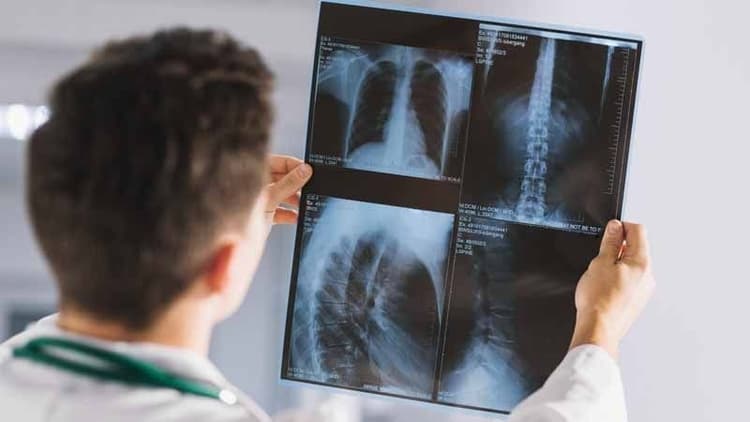Bone Density Test - Who Needs It & Why
2 months ago
3 minute read.

Bone Mineral Density (BMD) is a crucial indicator of osteoporosis and fracture risk. A lower BMD signifies a higher risk of fractures. To evaluate bone density, doctors commonly use a scan called Dual-Energy X-ray Absorptiometry (DEXA). DEXA is currently the most widely utilized and accurate test for measuring BMD.
Understanding and monitoring BMD can help prevent serious bone-related conditions, such as osteoporosis, which is characterized by weakened bones and an increased risk of fractures. The most accurate and widely used method to assess BMD is the Dual-Energy X-ray Absorptiometry (DEXA) scan. This non-invasive test measures the density of bones in various parts of the body, providing essential insights into bone health.
Osteoporosis often begins silently, without symptoms, until a fracture happens. Hence, identifying those at risk through a BMD test is crucial for early intervention and prevention. Low bone density, or osteopenia, is a condition where bone density is below normal levels but not low enough to be classified as osteoporosis. Individuals with low bone density have a higher chance of progressing to osteoporosis and are more susceptible to fractures.
Understanding Bone Density
Low bone density, or osteopenia, occurs when your bone density is lower than normal but not low enough to be classified as osteoporosis. This condition indicates a higher likelihood of developing osteoporosis in the future, as there is less bone mass to lose. Individuals with low bone density are more prone to fractures compared to those with normal bone density.
Who Should Undergo A BMD Test?
Anyone at risk of low bone density or osteoporosis should consider undergoing a BMD test. The test helps in preventing, controlling, or postponing osteoporosis. Key risk factors include:
- Gender: Women are more likely than men.
- Age: Bone density typically decreases with age.
- Menopause: Hormonal changes during menopause can accelerate bone loss.
- Family History: A family history of osteoporosis can increase risk.
- Steroid Medication: Long-term use of steroids can reduce bone density.
- Body Weight: Underweight individuals are at higher risk.
- Lifestyle Factors: Excessive intake of alcohol and carbonated beverages, smoking, and reduced physical activity.
- Nutritional Deficiencies: Lack of calcium and vitamin D.
Detecting Low Bone Density
A bone density test evaluates whether you have normal bone density, low bone density, or osteoporosis. It's essential to understand that low bone density doesn't necessarily mean active bone loss. Some individuals may have naturally lower bone density due to genetics, body size, or underlying health conditions. The likelihood of having low bone density increases with age.
Results Of A BMD Test
The results of a BMD test are typically expressed as T-scores and Z-scores:
T-Score
- -1 or higher: Normal bone density
- Between -1 and -2.5: Osteopenia (low bone density)
- -2.5 or lower: Osteoporosis
Z-Score
- Negative Z-score: Thinner bones than the average person of the same age
- Positive Z-score: Better bone density than the average person of the same age

Importance Of BMD Testing
- Prevention: Early detection of low bone density can lead to preventive measures to avoid fractures.
- Management: Helps in managing and treating existing bone density issues.
- Monitoring: Regular BMD tests can track bone health over time, allowing for timely interventions.
Preventing Bone Density Loss
- Nutrition: To promote bone health, consume a calcium- and vitamin D-rich diet. Dairy products, leafy greens, and fortified foods are all good sources.
- Exercise: Engage in weight-bearing and muscle-strengthening exercises regularly to maintain bone strength.
- Lifestyle Modifications: Avoid smoking and limit alcohol and carbonated beverage intake to protect your bones.
- Medications: If prescribed by a healthcare provider, take medications that help strengthen bones and reduce the risk of fractures.
Also Check: Foods That May Hamper Your Bone Mineral Density
Steps To Improve Bone Density
- Diet: Ensure you get enough calcium and vitamin D through your food and supplements.
- Exercise: Do weight-bearing and resistance exercises to keep your bones strong.
- Lifestyle Changes: Cut down on alcohol, quit smoking, and stay active.
- Medications: Follow your doctor’s advice on medications to strengthen your bones.
When To See A Doctor
Consult your doctor to determine if you need a BMD test. Based on the initial test results, your doctor will advise whether you need subsequent tests and how often they should be done. Regular monitoring is crucial for those with risk factors or already diagnosed with low bone density or osteoporosis.
Also check: Do You Have Bone Problems? It Could Be Due To A Vitamin D Deficiency
Conclusion
Bone density tests are vital for assessing the risk of osteoporosis and fractures, especially for those with risk factors. Early detection and proactive management can significantly improve bone health and reduce the risk of fractures. Always consult your healthcare provider to determine the best approach for maintaining and improving bone health.
Leave a Comment
Related Articles
Health Checks @ Home
Service
Explore
© 2025 Truworth Health Technologies Pvt. Ltd.





